|

Churches of Broseley and District
All
Saints Broseley
(St Leonard's)
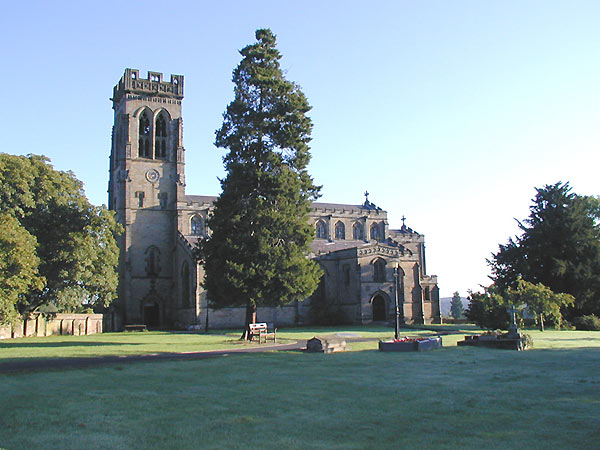
Broseley's
Parish Church dedicated to All Saints, built in 1845, which replaced a
former building which was dedicated to St Leonard. It stands in what was once the centre of the village, but as the
town grew the population settled further from the church building. In
the early 1700's, what was probably the original church, was completely
rebuilt bring complete by 1716. This church was in turn demolished the
present Victorian edifice being completed in 1845 at a cost
of 9,000. It is constructed of stone from Grinshill about 25 miles away.
It was at this time that the name was changed from St Leonard's to All
Saints.
Its architectural design is based on the great wool churches of
the south and west of England, although it does not touch their glory. The most noteworthy
feature is the tower, which since Broseley overlooks the Severn Gorge, is a prominent
landmark from the opposite side of the river.
When a new building was proposed there was a suggestion that it
be built of local brick the building committee being headed by Mr William Exley a local
brick manufacturer. The then Rector, the Hon. & Rev. O.W.W. Forester, a Canon of York
and later 4th Baron Forester, however, rejected the idea, The architect was of
Worcester.
The church contains a window by Kempe, and a rerados by Bodley.
There are a number of memorials to local worthies, including one telling a Cinderella
story. The silver, which has been removed for safe keeping, dates form the late 17th
century. There is a coat of arms of Queen Ann. The bells were cast by Mears of London in
1844, and are eight in number. There is also a Parsons Sanctus bell dating from 1642.
Broseley was a centre of iron making, and there are some
fascinating iron tomb "stones" in the churchyard. The church railings too are
fine examples of local craftsmanship. An ancient yew stands in the church grounds.
The registers go back to 1570, and are available in local
libraries.
The graveyard at St Leonards was extended in 1840.
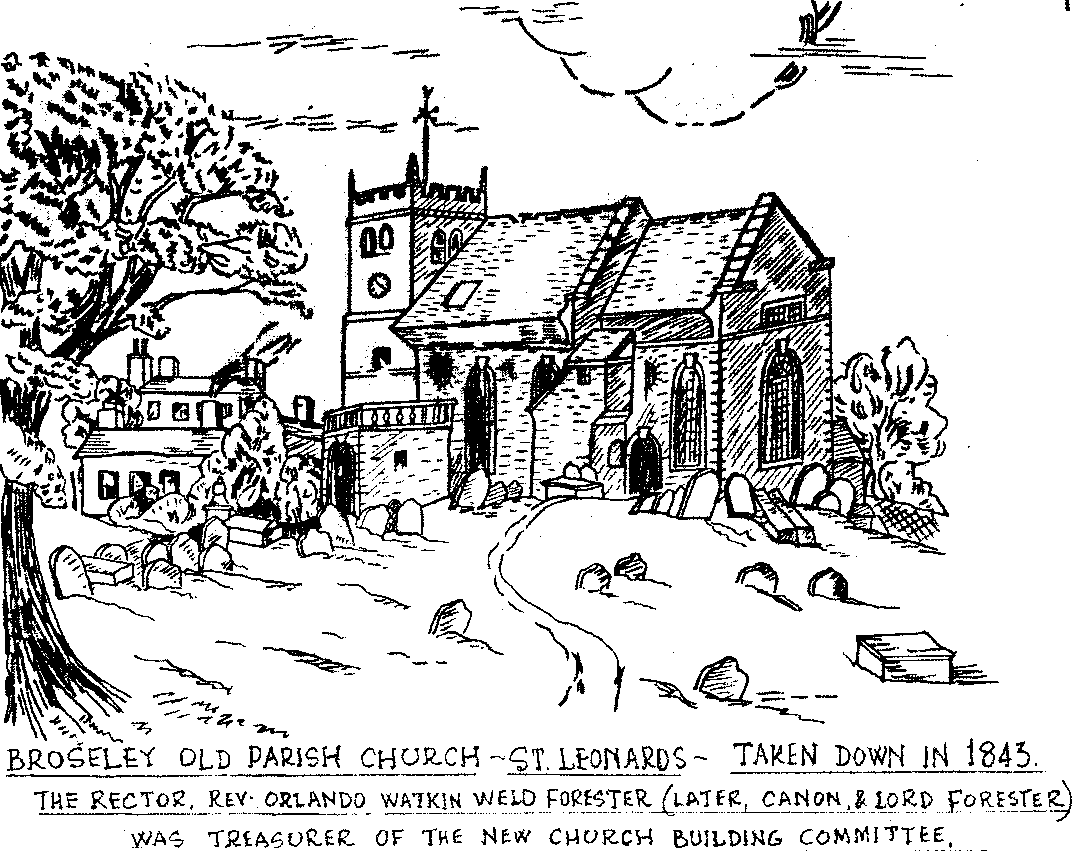

All Saints as it was in the
Early 20th Century
|
Broseley Cemetery
By 1880 the graveyard at All Saints was
becoming full and a new cemetery was required. To achieve this the Local
Board (local council) assumed the functions of a Burial Board under the
Internment Act of 1879. After many discussions it was decided to purchase
land in Duckhouse and Brandlee Meadows (near Oakleys catchgate) for 175
from Major General Jenkins. This land is adjacent to Ironbridge Road to the
north east of the Church. The cemetery was constructed by the firm of
Millington's and opened in 1884, it was extended in 1899 and again in 1969.
It is surrounded by a decorative brick wall and
has a chapel of rest which is an excellent advert for the products of the
local brick and tile industry.
The Chapel of Rest Broseley Cemetery.
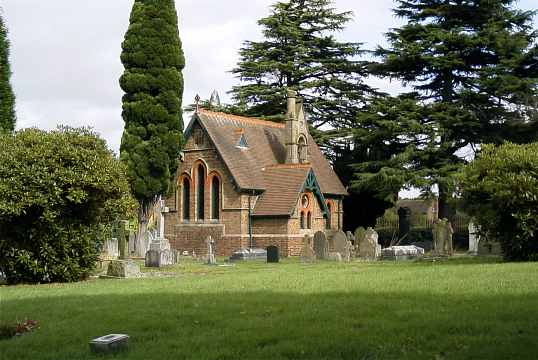 |
| St Mary Jackfield - The Red Church
-
See Friends web
page for more details 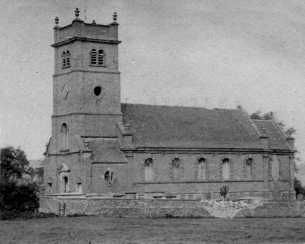 The
now demolished Chapel of Ease of St Mary at Jackfield is surrounded by a
number of mysteries. Some well placed authorities attribute its building
in 1759 to Francis Blithe Turner in memory of a female relative.
Other say it was paid for by Mrs Mary Browne, and set a later date of
1766. There is a popular legend that the deceased lady did not want
the church built on the conventional East-West alignment, and each night
rose from her grave to push down the work completed during the day.
Hence the church was built North to South. The
now demolished Chapel of Ease of St Mary at Jackfield is surrounded by a
number of mysteries. Some well placed authorities attribute its building
in 1759 to Francis Blithe Turner in memory of a female relative.
Other say it was paid for by Mrs Mary Browne, and set a later date of
1766. There is a popular legend that the deceased lady did not want
the church built on the conventional East-West alignment, and each night
rose from her grave to push down the work completed during the day.
Hence the church was built North to South.
The building quickly became unsafe, and although it had been built to save
those living along the Severn the journey to Broseley to worship, regular
services ceased in about 1860. A hundred years later the church, whose
architect some claimed to be Thomas Farnolls Prichard, celebrated for his
connection with the design and construction of the iron bridge, was
demolished.
The church was commonly known as The Red Church because of the
colour of the local brick used in its construction, but in the 19th
century was known as The Church on the Hill. In the century of its
construction it enjoyed the epithet of The New Church.
Close to the site is the Cholera Ground (1832) for the reception of
victims of that disease in one mass grave. A single tombstone marked
"T Crump" denotes the place, so it is claimed.
|
Jackfield Church
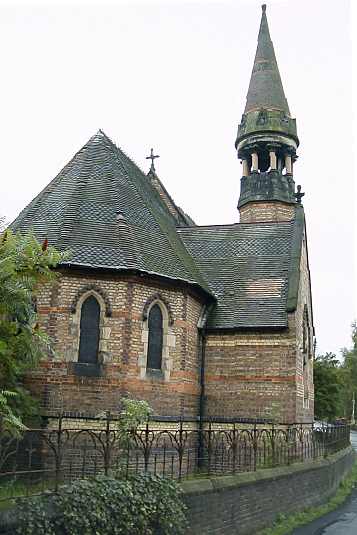 The village church at Jackfield can claim to be, architecturally, one
of the most distinguished buildings in the Severn gorge. It was
designed by the prominent Victorian Architect Sir Arthur William Blomfield
(1829-1899) architect of Selwyn College Cambridge, the Royal College of
Music London and St Mary's Portsea (Portsmouth Cathedral). It is in
the French Gothic style and makes extensive use of local materials.
In its use of layers of differing colours of brick it has a passing resemblance
to the Norman Shaw Buildings on the Embankment and Butterfield's Keble
College. The reredos is a remarkable triptych displaying local tiles
painted at the Craven Dunhill factory behind the Church and reputedly
first shown at the Paris Exhibition of 1862. Unusually for a parish
church there is a large rose window in the west wall. The village church at Jackfield can claim to be, architecturally, one
of the most distinguished buildings in the Severn gorge. It was
designed by the prominent Victorian Architect Sir Arthur William Blomfield
(1829-1899) architect of Selwyn College Cambridge, the Royal College of
Music London and St Mary's Portsea (Portsmouth Cathedral). It is in
the French Gothic style and makes extensive use of local materials.
In its use of layers of differing colours of brick it has a passing resemblance
to the Norman Shaw Buildings on the Embankment and Butterfield's Keble
College. The reredos is a remarkable triptych displaying local tiles
painted at the Craven Dunhill factory behind the Church and reputedly
first shown at the Paris Exhibition of 1862. Unusually for a parish
church there is a large rose window in the west wall.
The church itself was funded as a memorial to George Prichard sometime
High Sheriff of Salop. The other memorial to him, in the Broseley
square has been demolished. There is a memorial plaque to Alexander
Brodie, iron master of Calcutts who died 5th June 1830 some years before
the church was consecrated in 1863.
|
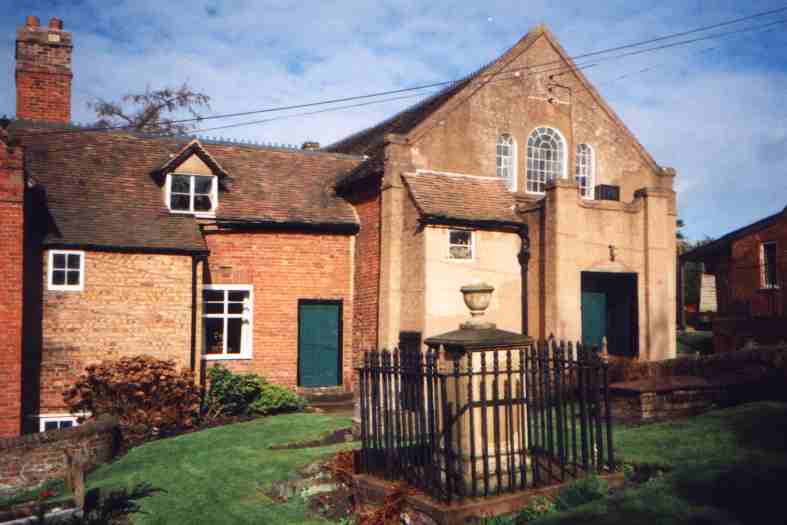 Baptist Chapel Baptist Chapel
According to an old book
containing the confession of faith, a list of members, a register of births, deaths,
&c., and other matters in connection with the " Old Baptists at Broseley,"
it appears that this body first established themselves here in 1741. The following
statement is from page 7.
"The preaching of the Gospel at Broseley was began at ye house of Jacob Wyke ye
sixteenth day of September, 1743, by Mr. John Oulton, pastor of ye Baptist Church in
Leominster, and by him Mr. Robert Morris, of Wellington, &c. There were preached abt.
ten Sermons before the new Chappel was opened which was ye second day of February. 1741-2,
from wch. time for about ye space of 2 years we had no constant supply but what by the
providence of God ministers of other congregations were sometimes sent to assist us and
some of them from very different places from us in which time several persons received the
Gospel and were Baptised afterwards Mr. John Waine who had been one of our helpers came
and resided with us and ye number of converts was increased to abt. fifteen whereof there
were four men viz., Jacob Wyke, Thomas Jones, John Jones, and George Cartwright, who on or
about ye first of December, 1749 (according to ye Gospel rule) .."
From John Randall History of Broseley 1879 |
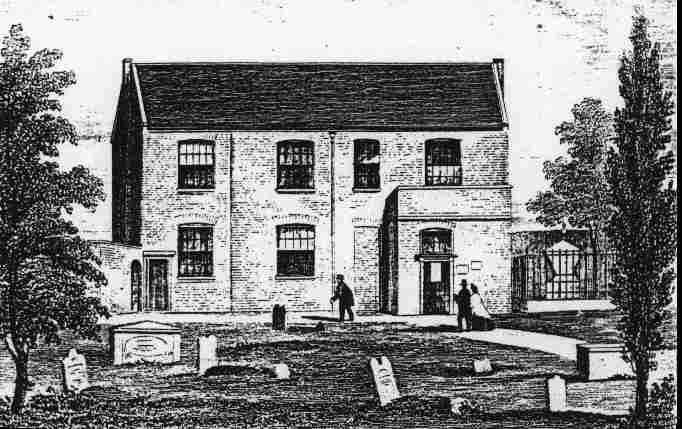 The Birchmeadow Chapel
Birchmeadow Chapel is also now a community centre
owned by the Town Council. The Birchmeadow Chapel
Birchmeadow Chapel is also now a community centre
owned by the Town Council.
It was built as a Baptist Chapel in 1803 jointly by John Guest ( of the GKN steel company)
and George Crompton (draper). In more recent times it has been the
Elite Cinema, a night-club and during WW2 it was used by the local APR and Home Guard. This
engraving shows the chapel as it was built. In subsequent years extensions have been
added. |
Broseley Methodist
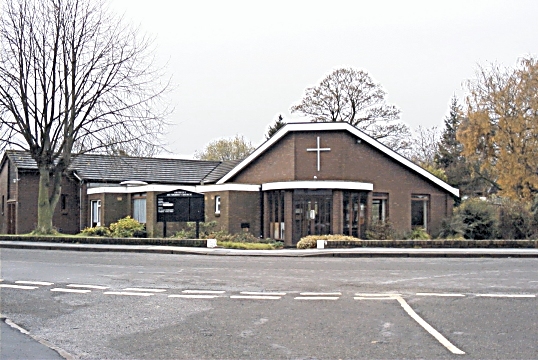 This is
one of two non-conformist places of worship still in regular use. This is
one of two non-conformist places of worship still in regular use.
John Randall (Broseley and its Surroundings 1879) states:
We have not been able to ascertain the exact date at which Wesleyan
Methodism was first established in Broseley, or that at which the chapel
was built. The latter is said
to have been erected in 1772; and it is probable enough that that event
took place prior to the visits paid by the founder of Methodism. Mr.
Wesley twice visited Broseley, and the wonderfully accurate records of the
journeyings of that remarkable man supply the exact dates of his visits.
Having been at Shrewsbury on the 28th and 29th of July, 1774, he says:
Sat. 30. - I went on to Madeley; and in the evening preached under a
sycamore-tree, in Madeley-Wood, to a large congregation, good part of them
colliers, who drank in every word. Surely never were places more alike, than Madeley-Wood,
Gateshead-fell, and Kings-wood.
Sun. 31. -The church could not contain the congregation, either
morning or afternoon but in the evening I preached to a still larger
congregation at Broseley; and equally attentive. I now learned the
particulars of a remarkable story, which I had heard imperfectly before:-
Some time since, one of the colliers here, coming home at night, dropped
into a coal-pit, twenty-four yards deep.
He called aloud for help, but none heard all that night, and all
the following day. The second
night, being weak and faint, he fell asleep, and dreamed that his wife,
who had been some time dead, came to him, and greatly comforted him. In
the morning, a gentleman going a hunting, an hare started up just before
the hounds, ran straight to the mouth of the pit, and was gone; no man
could tell how. The hunters
searched all round the pit, till they heard a voice from the bottom. They
quickly procured proper help, and drew up the man unhurt.
Again being at Shrewsbury, (April, 1780), he says: -
Not knowing the best way from hence to Brecon, I thought
well to go round by Worcester. I took Broseley in my way, and thereby had
a view of the iron bridge over the Severn: I suppose the first and the
only cue in Europe. It will not soon be imitated.
In the evening I preached at Broseley; and on Saturday, 21, went on to
Worcester.
The old chapel had seats for 384 and was in a classical style with
pedimented porch and facade. It was closed an demolished in
1964. The replacement chapel was completed in 1971.
|
Wesleyan Chapel at Coalford
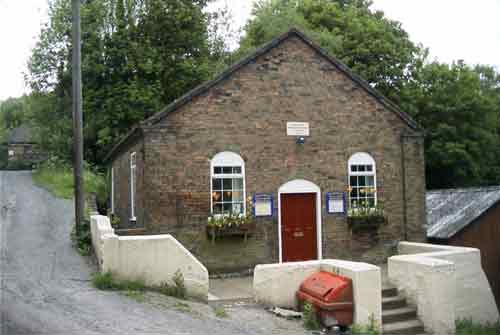
This chapel was built for the accommodation of those of the Wesleyan
persuasion living at Coalford, Jackfield, and the Lloyd
Head.
It cost 275, with the ground; and was first opened for divine
worship on Sunday, Nov. 24th, 1825. A house for the chapel-keeper was been added, which in the
1880's was occupied by a very worthy and truly pious self-taught
man, Aaron Langford, an energetic local preacher, usually designated
the bishop of Coalford..
The chapel closed in 1980 an is currently the headquarters of the
Jackfield Elcock Reisen Band
|
Primitive Methodist - Broseley Wood
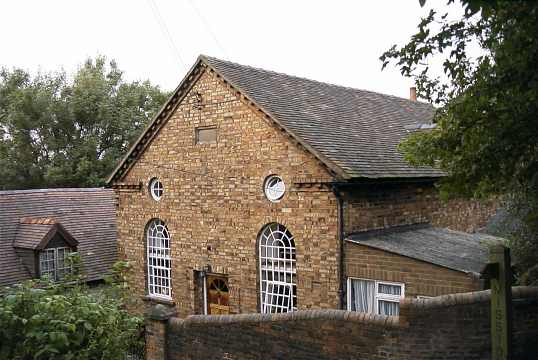
The Primitive Methodists opened a chapel in Broseley Wood in 1839.
In 1851 the chapel was attended by 37 adults in the afternoon and 91 in
the evening. For a time it was taken by the C of E
as a mission church It ceased to be used for worship
about1970 and is now a
private residence. |
Congregationalists
This was on the site of the Friends Meeting house which with some
additional land was purchased and a chapel was built in 1841 at a
cost of 700; and the old building was fitted up for a school-room.
Randall states that:
For some years, the church flourished; but through changes in trade
and manufactures, its membership declined.
Mr. Samuel Evans laboured here gratuitously for 17 years, with such
effect that he has now a fixed stipend, and has gone to reside at Broseley.
Among the earlier ministers was the Rev. Samuel Newth, M.A., a
distinguished scholar and mathematician of the London University, and now
Dr. Newth, Principal of New College, London, and one of the company of
the Revisers of the English New Testament.
The chapel closed in 1965 and was later demolished. The site is now
the car park for the Pipeworks Museum but a small graveyard remains. |
|
Quaker
John Randall (Broseley and its Surroundings 1879) states:
The Broseley Meeting-House was erected in 1692, at which time the
mineral property of the district was becoming appreciated. The old Meeting
House at Broseley was then the only one for Friends on both sides of the
Severn, the present one at the Dale not being built till some time
afterwards. Funerals from Coalbrookdale, attended by horsemen or
carriages, had to go over Buildwas bridge, and across Benthall Edge. The
inconvenience felt in this respect is said to have suggested to the Darbys
the advisability of a bridge over the Severn; an idea strongly entertained
by the second Abraham Darby, and finally matured and carried out by the
third.
Among the earliest marriages recorded here is that of John Tipper, of
Lower Arley, Worcester, to Mary Edwards of Benthall 31st 3rd mo. 1691.
Samuel Roden, son of Samuel Roden, carpenter, Broseley, was married to Ann
Powell of Broseley, 27th 8th mo. 1723. Edward Cliveley, of Much Wenlock,
was married to Martha Meredith, Much Wenlock, 2nd 1st mo. 1719. Thomas
Rose, Coalbrookdale, hinge maker, son of Thomas and Rebecca Rose, of
Birmingham, was married to Debora Richardson of Coalbrookdale, 21st 6th
mo. 1726. There are other marriages, but the burials recorded are much
more numerous, shewing an immigration probably of Friends from a
distance to the works. The number is 85; and amongst them several members
of the old family of Bradley, Andrew Bradley, son of Andrew and Bretage,
1702. Some of these were of Benthall and Horsehay. Ten of the Darbys are
among the number.
After the meeting house at Coalbrookdale opened in 1741 the friends
ceased to meet in Broseley. The meeting house finally closed 1778
the site being used later by the Congregationalists for their Chapel. |
Roman Catholic
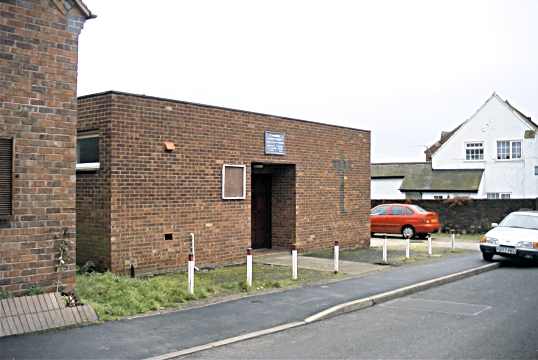 Prior to 1888 when an "iron church" was opened
mass had been celebrated in private houses. St Winifreds, as it was known
was closed in 1913. Worship returned to Broseley in 1962 when a
wooden church was built on land in Barbers Row. This was replace by
the present brick building in 1979. Prior to 1888 when an "iron church" was opened
mass had been celebrated in private houses. St Winifreds, as it was known
was closed in 1913. Worship returned to Broseley in 1962 when a
wooden church was built on land in Barbers Row. This was replace by
the present brick building in 1979.
Broseley has never been a Catholic parish and has being served from
Madeley, Shifnal, Dawley and currently Much Wenlock.
|
Gospel
Rooms - Victoria Hall
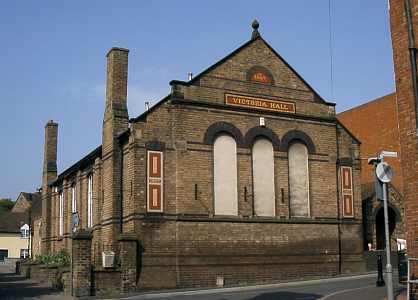 The hall was built in 1867 by the Plymouth Brethren as
the Gospel Rooms and was partly financed by the Maw family. Around
1905 they moved to Broseley Wood where the met until 1927.
The hall was built in 1867 by the Plymouth Brethren as
the Gospel Rooms and was partly financed by the Maw family. Around
1905 they moved to Broseley Wood where the met until 1927.
The hall had a number of uses, as a billiard hall, the local library and
currently it is used as a venue for community events. |
Linley Church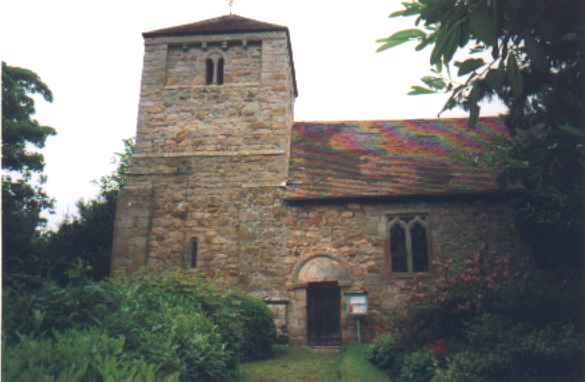 Linley
church is a gem. It stands a little off the B4373 Broseley to Bridgnorth road, and is
approached down a single-track road which itself is a flower filled attraction at certain
times of the year. The building was consecrated to St Leonard in 1138 and since then has
changed little except for the insertion of 13th or 14th century
windows. Ever the Victorians dealt kindly with Linley, chiefly replacing the dilapidated
East Wall. Linley
church is a gem. It stands a little off the B4373 Broseley to Bridgnorth road, and is
approached down a single-track road which itself is a flower filled attraction at certain
times of the year. The building was consecrated to St Leonard in 1138 and since then has
changed little except for the insertion of 13th or 14th century
windows. Ever the Victorians dealt kindly with Linley, chiefly replacing the dilapidated
East Wall.
There are deeply splayed windows, and well-proportioned Norman arches with charming
scrolled carvings
|
|
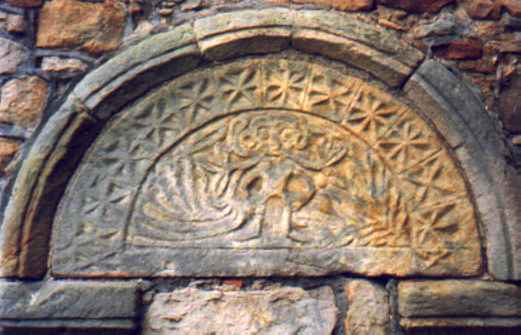 The outside of the church is as interesting as its
interior. The outside of the church is as interesting as its
interior.
The faces carved into the tower need to be noted. The north doorway is blocked up, but its typanum
(shown right) contains on of
the few sheila-na-gigs in the country. In this case we have a green man a fertility symbol
remaining over from the old religion with foliage sprouting from his mouth.
The deeply splayed, round-headed windows are of
considerable interest. The huge but roughly hewn font is Norman. There is a splendid
typanum in the original west doorway.
The silver, which is not held in the church, is dated 1625.
Ancient church shuts doors to worshippers
by Sarah Hughes - Bridgnorth Journal 2nd November 2007
An historic church near Broseley dating back about
1,000 years has been made redundant due to lack of funds.
St Leonard's Church, which stands off the B4373 Broseley to Bridgnorth road
in Linley, was made redundant on September 24.
Plans are now being drawn up to hand over the building to the Churches
Conservation Trust.
The trust, if given the go ahead, will preserve the church and its annexed
land.
The nearby Barrow Church will now be used as the
parish church for Linley, Barrow and Willey.
Reverend Mike Kinna said: "We couldn't afford to keep two churches going.
It's a shame but it's reality.
"Churches are important buildings, many with listed status, and they have to
be kept to a certain standard. Sometimes the only way to do this is to hand
them over to organisations like the Churches Conservation
Trust."
Rev Kinna said: "The foundations of the church are probably around I,000
years old. It's an important archaeological buildings, with stone carvings
and a Norman font.
"Barrow is a similar age, although its foundations are older. It was a place
of worship back in the 8th century.
"It's now the parish church for all the parishes.
"There will now be a huge effort going on to restore Barrow church. Various
things need doing like rewiring and roofing.
"Lots of things have already been going on, we are having fundraisers all
the time."
The Churches Conservation Trust is the leading body conserving England's
most beautiful and historic churches which are no longer used for regular
worship.
It promotes public enjoyment of these churches, and encourages their use as
an educational and community resource.
There are currently 340 churches in its care, including St Leonards, in
Bridgnorth.
|
Benthall Church
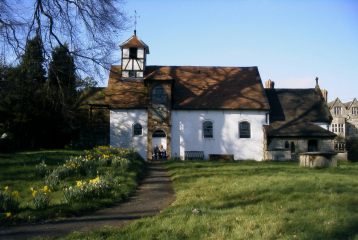 The
church is somewhat overshadowed by Benthall Hall (National Trust). It appears that what
was an earlier church (dedicated to St Brice, the only other being at Brize Norton, Oxon)
was substantially lost during the defence of the hall in 1645, one of the skirmishes in
the Civil War. It was not until 1667 that the church was rebuilt although in a local
style. At that time the dedication was given as St Bartholomew. The
church is somewhat overshadowed by Benthall Hall (National Trust). It appears that what
was an earlier church (dedicated to St Brice, the only other being at Brize Norton, Oxon)
was substantially lost during the defence of the hall in 1645, one of the skirmishes in
the Civil War. It was not until 1667 that the church was rebuilt although in a local
style. At that time the dedication was given as St Bartholomew.
Internally the church contains a great west gallery, used over the years for the
musicians and singers.
The Victorians enlarged the building in their own unique way. A particularly unusual
feature is the Blocked up south doorway, which contains a beehive, the entrance to which
is a lion's face. Above are written the words " Out of the strong commeth forth
sweetness". St Bartholomews Church, pictured right, was built
in 1667 after the previous church burnt down during the Civil War.
Shropshire Star 19th July
2007
St Bartholomews Church, was built in 1667 after the previous church
burnt down during the Civil War. It will become
redundant on August 31. On August 26, there will be a holy eucharist at
10.30am.
Rector of Broseley the Reverend Mike Kinna, whose patch includes
Benthall, said: It will be a celebration of its ministry to date and a look
forward to the future. It will be in no way a wake.
Its a move to ensure its future, which might sound completely at odds
with the word redundant, but thats the way church law works.
Its mainly because its not attended by very many, therefore the income
is minute, and not in any sense or any way enough to maintain and keep a
listed building the way it should be kept.
|
Barrow The church at Barrow
stands on an ancient site. It is constructed on a small hillock, about which there is some
speculation that is connected with the Celtic saint, St Owen. A holy well of his is at
Much Wenlock about three miles away. The church at Barrow
stands on an ancient site. It is constructed on a small hillock, about which there is some
speculation that is connected with the Celtic saint, St Owen. A holy well of his is at
Much Wenlock about three miles away.
The present chancel is the original "cell" chapel, and opinion is that its
dates from early in the 8th century, although the Victorians managed to
replace one wall. It is dedicated to St Giles who died in 712. It is a good example of the
earliest churches in these islands.
The nave is late Saxon with some remodeling by the Normans. The tower was added in the
century following the last millennium.
Outside there are further items of interest. Near the church door lies Tom Moody, the
whipper-in for the local Squire Forester, and frequently referred to as the Shropshire
John Peel. A large iron grave monument covers the resting-place of John Rose of the
Coalport China manufactory. Outside the churchyard is an unusual horse mounting stone.
Near the Church are the Almshouses (1619) and the School (1612) founded by John Slaney
of London.
|
Willey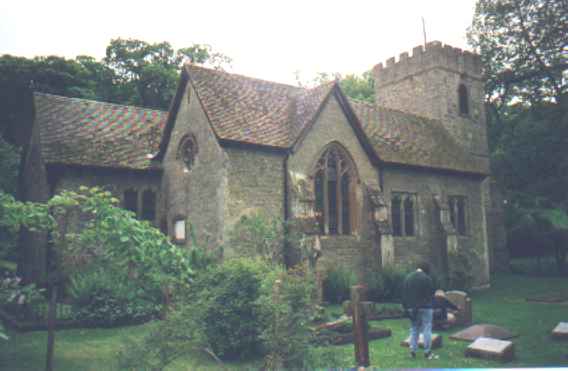 The church stands
between Willey Old Hall, an attractive Tudor Building and Willey Park (1816), the
residence of (Lord and) Lady
Forester. The building is basically Norman but the heavy hand of the Victorians is upon it.
It was restored and enlarged in 1880 The church stands
between Willey Old Hall, an attractive Tudor Building and Willey Park (1816), the
residence of (Lord and) Lady
Forester. The building is basically Norman but the heavy hand of the Victorians is upon it.
It was restored and enlarged in 1880
Willey
Parish Registers |
|
|
|
|

 Baptist Chapel
Baptist Chapel The Birchmeadow Chapel
Birchmeadow Chapel is also now a community centre
owned by the Town Council.
The Birchmeadow Chapel
Birchmeadow Chapel is also now a community centre
owned by the Town Council.  This is
one of two non-conformist places of worship still in regular use.
This is
one of two non-conformist places of worship still in regular use.

 Prior to 1888 when an "iron church" was opened
mass had been celebrated in private houses. St Winifreds, as it was known
was closed in 1913. Worship returned to Broseley in 1962 when a
wooden church was built on land in Barbers Row. This was replace by
the present brick building in 1979.
Prior to 1888 when an "iron church" was opened
mass had been celebrated in private houses. St Winifreds, as it was known
was closed in 1913. Worship returned to Broseley in 1962 when a
wooden church was built on land in Barbers Row. This was replace by
the present brick building in 1979. The hall was built in 1867 by the Plymouth Brethren as
the Gospel Rooms and was partly financed by the Maw family. Around
1905 they moved to Broseley Wood where the met until 1927.
The hall was built in 1867 by the Plymouth Brethren as
the Gospel Rooms and was partly financed by the Maw family. Around
1905 they moved to Broseley Wood where the met until 1927.


 The
now demolished Chapel of Ease of St Mary at Jackfield is surrounded by a
number of mysteries. Some well placed authorities attribute its building
in 1759 to Francis Blithe Turner in memory of a female relative.
Other say it was paid for by Mrs Mary Browne, and set a later date of
1766. There is a popular legend that the deceased lady did not want
the church built on the conventional East-West alignment, and each night
rose from her grave to push down the work completed during the day.
Hence the church was built North to South.
The
now demolished Chapel of Ease of St Mary at Jackfield is surrounded by a
number of mysteries. Some well placed authorities attribute its building
in 1759 to Francis Blithe Turner in memory of a female relative.
Other say it was paid for by Mrs Mary Browne, and set a later date of
1766. There is a popular legend that the deceased lady did not want
the church built on the conventional East-West alignment, and each night
rose from her grave to push down the work completed during the day.
Hence the church was built North to South. The village church at Jackfield can claim to be, architecturally, one
of the most distinguished buildings in the Severn gorge. It was
designed by the prominent Victorian Architect Sir Arthur William Blomfield
(1829-1899) architect of Selwyn College Cambridge, the Royal College of
Music London and St Mary's Portsea (Portsmouth Cathedral). It is in
the French Gothic style and makes extensive use of local materials.
In its use of layers of differing colours of brick it has a passing resemblance
to the Norman Shaw Buildings on the Embankment and Butterfield's Keble
Coll
The village church at Jackfield can claim to be, architecturally, one
of the most distinguished buildings in the Severn gorge. It was
designed by the prominent Victorian Architect Sir Arthur William Blomfield
(1829-1899) architect of Selwyn College Cambridge, the Royal College of
Music London and St Mary's Portsea (Portsmouth Cathedral). It is in
the French Gothic style and makes extensive use of local materials.
In its use of layers of differing colours of brick it has a passing resemblance
to the Norman Shaw Buildings on the Embankment and Butterfield's Keble
Coll Linley
church is a gem. It stands a little off the B4373 Broseley to Bridgnorth road, and is
approached down a single-track road which itself is a flower filled attraction at certain
times of the year. The building was consecrated to St Leonard in 1138 and since then has
changed little except for the insertion of 13th or 14th century
windows. Ever the Victorians dealt kindly with Linley, chiefly replacing the dilapidated
East Wall.
Linley
church is a gem. It stands a little off the B4373 Broseley to Bridgnorth road, and is
approached down a single-track road which itself is a flower filled attraction at certain
times of the year. The building was consecrated to St Leonard in 1138 and since then has
changed little except for the insertion of 13th or 14th century
windows. Ever the Victorians dealt kindly with Linley, chiefly replacing the dilapidated
East Wall. The outside of the church is as interesting as its
interior.
The outside of the church is as interesting as its
interior. The
church is somewhat overshadowed by Benthall Hall (National Trust). It appears that what
was an earlier church (dedicated to St Brice, the only other being at Brize Norton, Oxon)
was substantially lost during the defence of the hall in 1645, one of the skirmishes in
the Civil War. It was not until 1667 that the church was rebuilt although in a local
style. At that time the dedication was given as St Bartholomew.
The
church is somewhat overshadowed by Benthall Hall (National Trust). It appears that what
was an earlier church (dedicated to St Brice, the only other being at Brize Norton, Oxon)
was substantially lost during the defence of the hall in 1645, one of the skirmishes in
the Civil War. It was not until 1667 that the church was rebuilt although in a local
style. At that time the dedication was given as St Bartholomew. The church at Barrow
stands on an ancient site. It is constructed on a small hillock, about which there is some
speculation that is connected with the Celtic saint, St Owen. A holy well of his is at
Much Wenlock about three miles away.
The church at Barrow
stands on an ancient site. It is constructed on a small hillock, about which there is some
speculation that is connected with the Celtic saint, St Owen. A holy well of his is at
Much Wenlock about three miles away. The church stands
between Willey Old Hall, an attractive Tudor Building and Willey Park (1816), the
residence of
The church stands
between Willey Old Hall, an attractive Tudor Building and Willey Park (1816), the
residence of